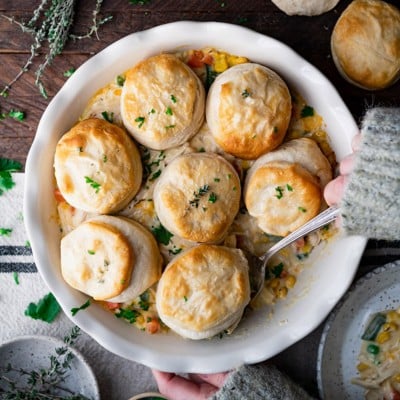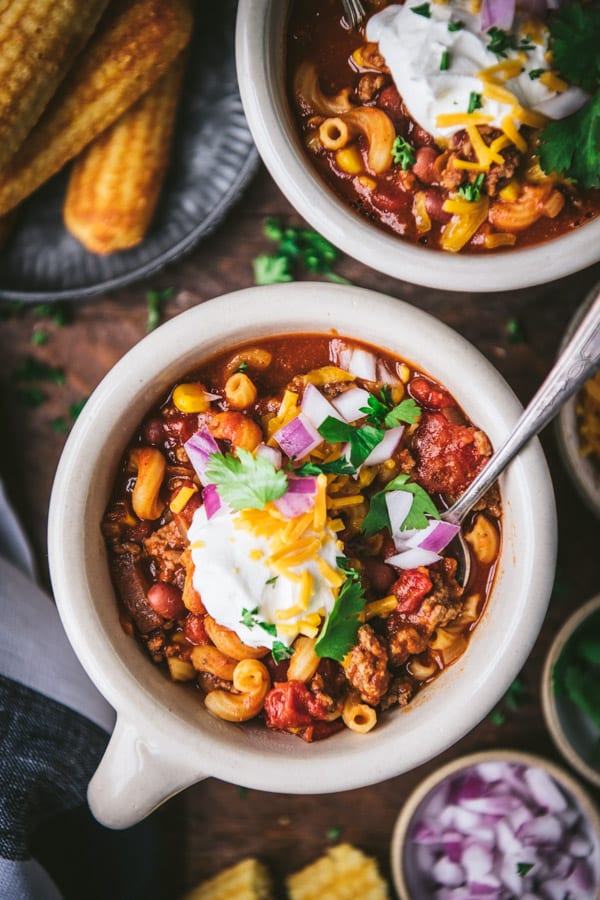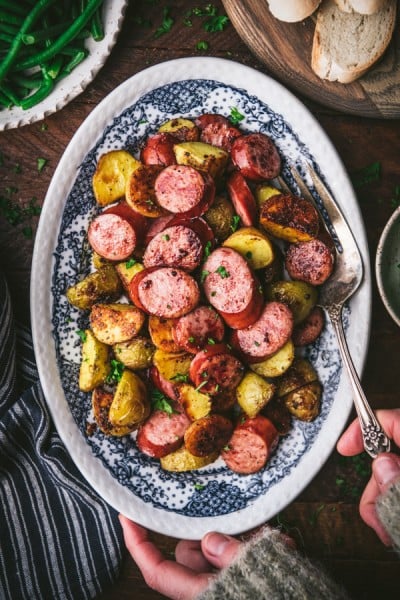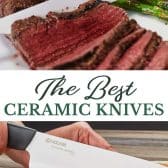Disclosure: This post may contain affiliate links. I may earn a small commission for my endorsement, recommendation, testimonial, and/or link to any products or services from this website.
Ceramic knives are becoming more popular as people catch onto their long-term durability. If you’re working with dull, old knives, it’s going to reflect in your chopping, mincing, and slicing. Plus, a knife that’s in bad shape could even make an accident more likely to happen, so consider replacing your old blades with the best ceramic knives.
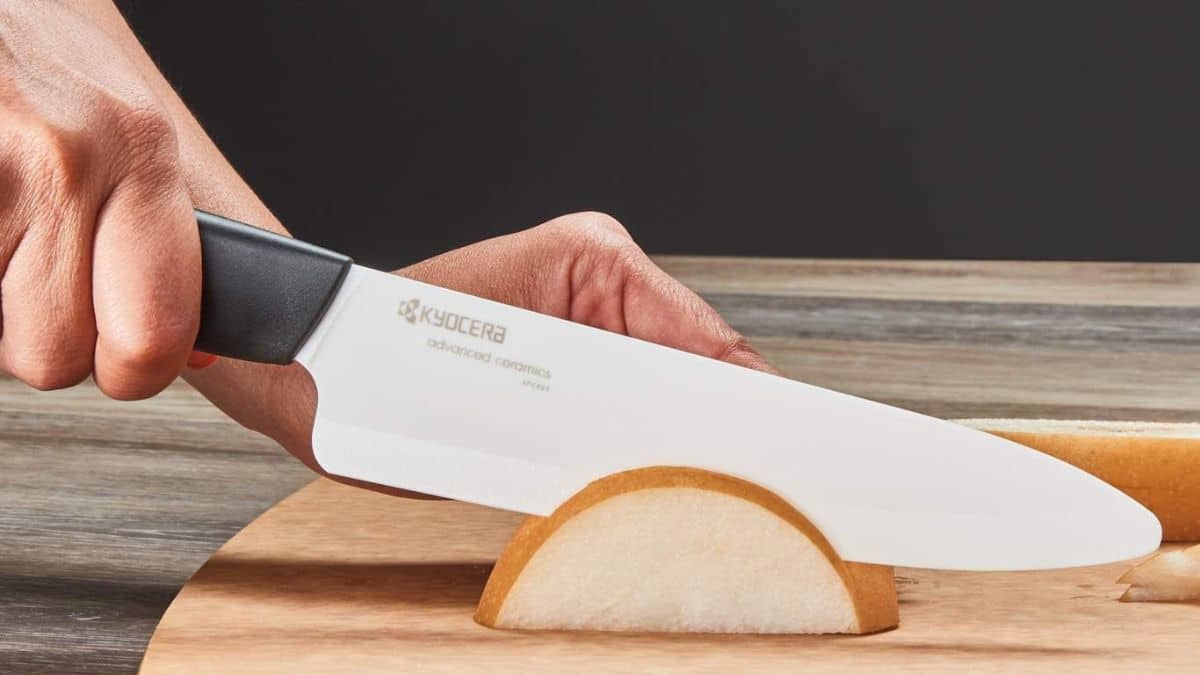
Table of Contents
Ceramic kitchen knives need a bit of TLC, but with proper care, their razor-sharp blades will last you a long, long time, while still expertly cutting through produce, herbs, and slices of meat.
Blair and I researched the best ceramic knives and knife sets for cooks of all different skill levels and were seriously impressed by brands like Cuisinart, Kyocera, and Vos, as well as a few runner-ups from other popular brands.
Our Top Picks:
- Best Overall: Kyocera Revolution 4-Piece Ceramic Knife Set – $76.31 at Amazon
- Best Ceramic Steak Knives: Kyocera 4-Piece Micro Serrated Ceramic Steak Knife Set – $71.28 at Amazon
- Best Ceramic Knife Starter Set: Vos Ceramic Knife Set – $24.99 at Amazon
- Best Ceramic Coated Knife Set: Cuisinart Advantage Color Collection 12-Piece Knife Set with Blade Guards – $28.90 at Amazon
Reviews of The Best Ceramic Knives
1. Best Overall: Kyocera Revolution 4-Piece Ceramic Knife Set
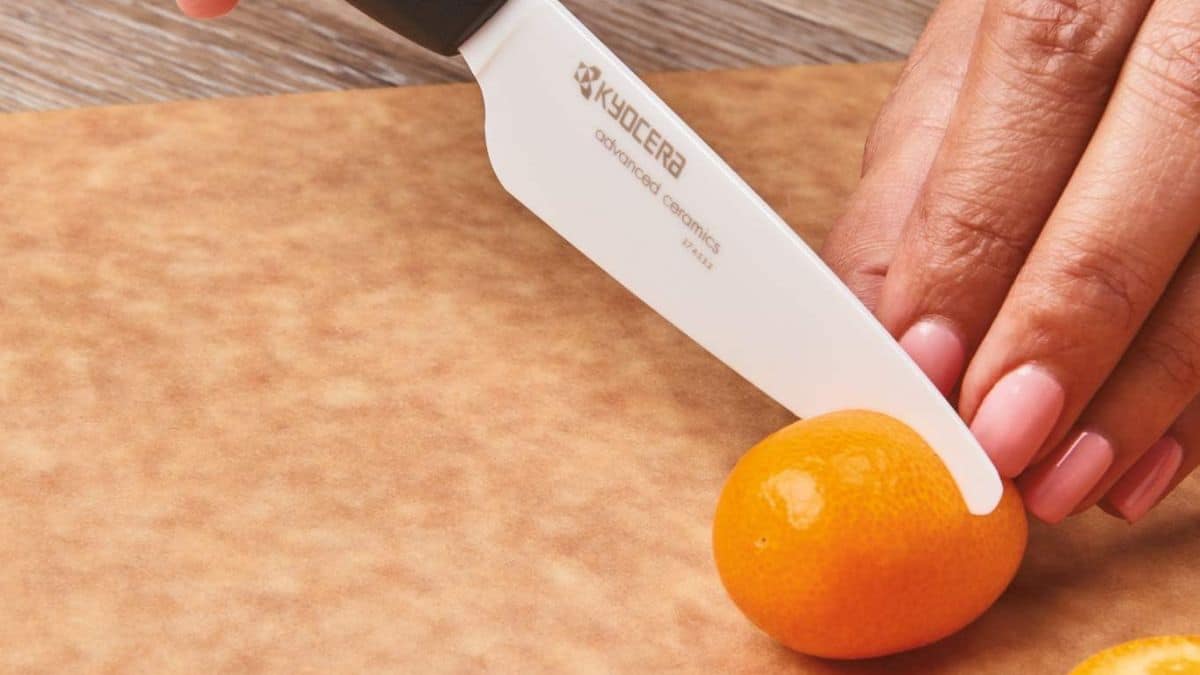
This complete four-piece set from Kycocera comes with a good selection of knives so you can prep anything: a 7-inch chef’s santoku knife, a 5.5-inch santoku knife, a 4.5-inch utility knife, and a 3-inch paring knife. The set ticks off every box and truly is everything you need in a ceramic knife set, whether you’re thinly slicing fruit or cutting the perfect slice of sandwich meat.
While these knives should not be used on frozen foods, as the blades may chip or break, they are dishwasher-safe (top rack only) and therefore much more convenient to clean than some other models. They’re also extremely durable, so long as you take care of them.
Tip: You won’t want to twist the blade or fling these knives into the sink when you’re done cutting; otherwise, they’re more likely to chip. However, if you take care of your knives, you can plan to have this set for a while without having to sharpen them professionally. And, if the time comes that they could use sharpening, Kyocera also offers professional resharpening services for their products.
The Specs:
- Handle Material: Plastic
- Construction Type: Stamped
- Set Includes: 7-inch ceramic chef’s santoku, 5.5-inch santoku, 4.5-inch utility, and 3-inch paring knives
The Pros:
- Very sharp blades
- Lightweight
- Ergonomic for easy holding
- Dishwasher safe and easy to clean
The Cons:
- Handle material could be more durable
- Might be prone to chipping
What Others Are Saying
The Kyocera Revolution 4-Piece Ceramic Knife Set has a 4.4-star rating on Amazon, and individual knives from the set have been ranked by both Robb Report and The Spruce Eats.
Buy the Kyocera Revolution 4-Piece Ceramic Knife Set:
2. Best Ceramic Steak Knives: Kyocera 4-Piece Micro Serrated Ceramic Steak Knife Set
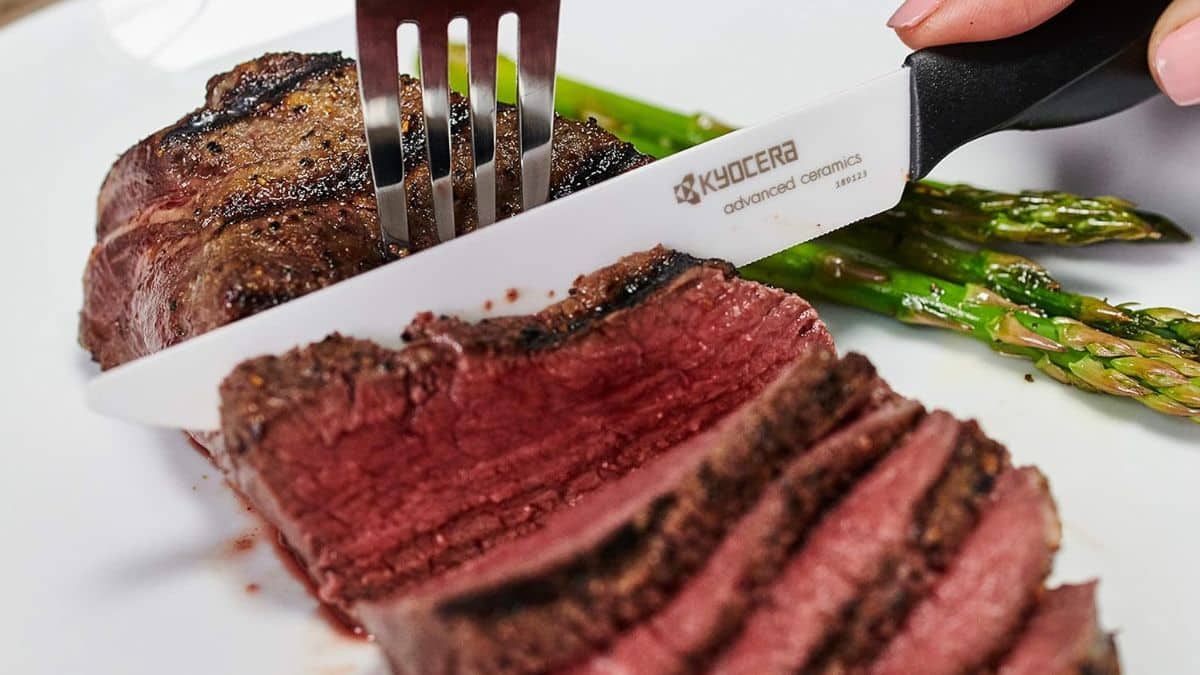
When searching for the best ceramic knives, Kyocera is a brand that’s hard to miss, so they’re on our list two. A trusted brand with a lot of happy customers and hype, Kyocera knives are some of the sharpest ceramic knives there are, and these micro-serrated ones are perfect for choice cuts of boneless meat.
Each 4.45-inch knife has a slightly curved handle that offers the user the most balance and stability while cutting, and the ceramic is Kyocera’s own proprietary material made in Japan (so you know it’s high quality). They’re non-corrosive, won’t transfer a metallic taste or brown food, and are conveniently top-rack dishwasher safe, so they’re easy to clean, too.
The Specs:
- Handle Material: Plastic
- Construction Type: Stamped
- Block Dimensions: 11.2 x 6.3 x 0.89 inches
- Set Includes: 4 4.5-inch steak knives with micro-serrated blades
The Pros:
- Dishwasher safe and easy to clean
- Lightweight
- Extremely sharp
The Cons:
- Somewhat pricey
- Blade beveled only on one side
Buy the Kyocera 4-Piece Micro Serrated Ceramic Steak Knife Set:
3. Best Ceramic Knife Starter Set: Vos Ceramic Knife Set
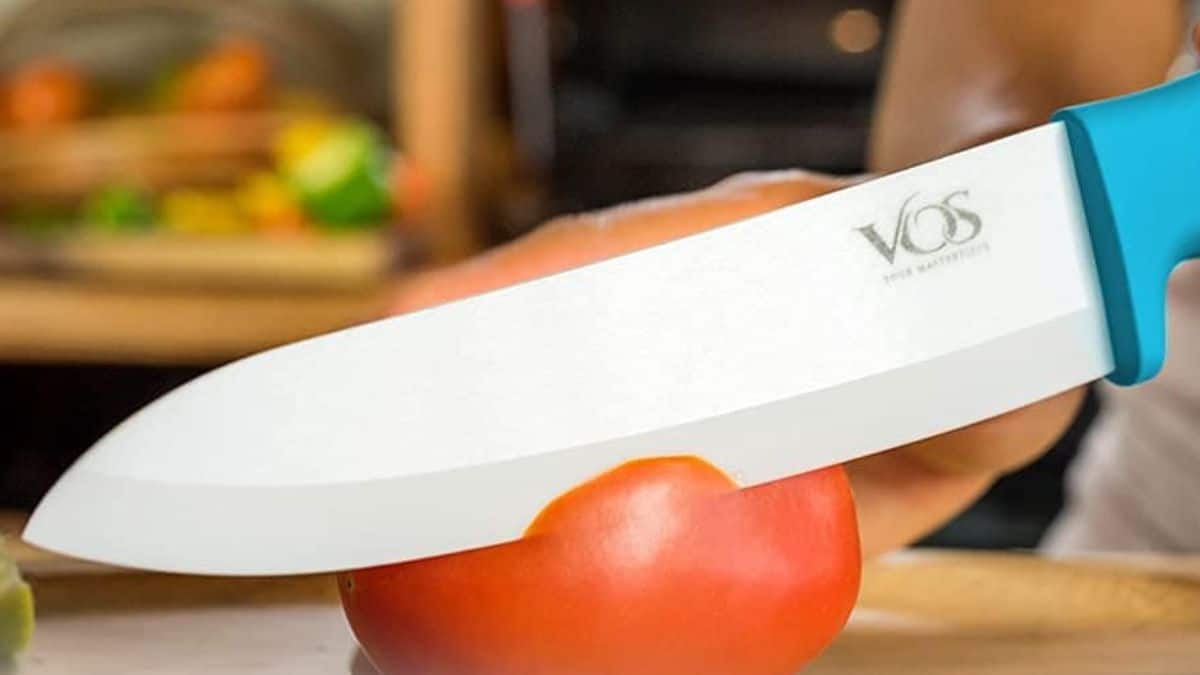
The perfect balance of an affordable yet well-made knife set, this four-piece from Vos makes a great gift for a new apartment or an amateur chef just starting their cooking journey. Included are three knives and a peeler, all of which are color-coded so it’s easy to avoid cross-contaminating the knives across different cutting jobs.
The red chef’s knife is perfect for cutting through my Southern Meatloaf Recipe or carving yourself a slice of Rosemary Oven Roasted Chicken. The blue utility knife is really a jack of all trades, so you can use it for just about anything, and the green paring knife is perfect for getting nice, thin slices out of apples like for my Braised Cabbage with Apples and Bacon recipe.
These Vos ceramic knives are lightweight enough for nervous knife users to use confidently, but not so lightweight that you have to worry about it slipping out of your hand. The ergonomic grip fits comfortably and provides a decent amount of precision as you glide along the cutting board.
The Specs:
- Handle Material: Stainless steel
- Set Includes: 6-inch, 4-inch, and 3-inch ceramic knives with 4 protective sheaths, 1 ceramic peeler, and storage box
The Pros:
- Extremely affordable
- Color-coded for certain types of cuts
- Ergonomic grip for easy, stable holding
The Cons:
- Not dishwasher safe
- Does not include guard or sheath for protection
- May chip
What Others Are Saying
The Vos Ceramic Knife Set has a 4.4-star rating from over 4,800 reviews on Amazon, and The Spruce Eats named the paring knife Best Paring Knife.
Buy the Vos Ceramic Knife Set:
4. Best Ceramic Coated Knife Set: Cuisinart Color Collection 12-Piece Knife Set
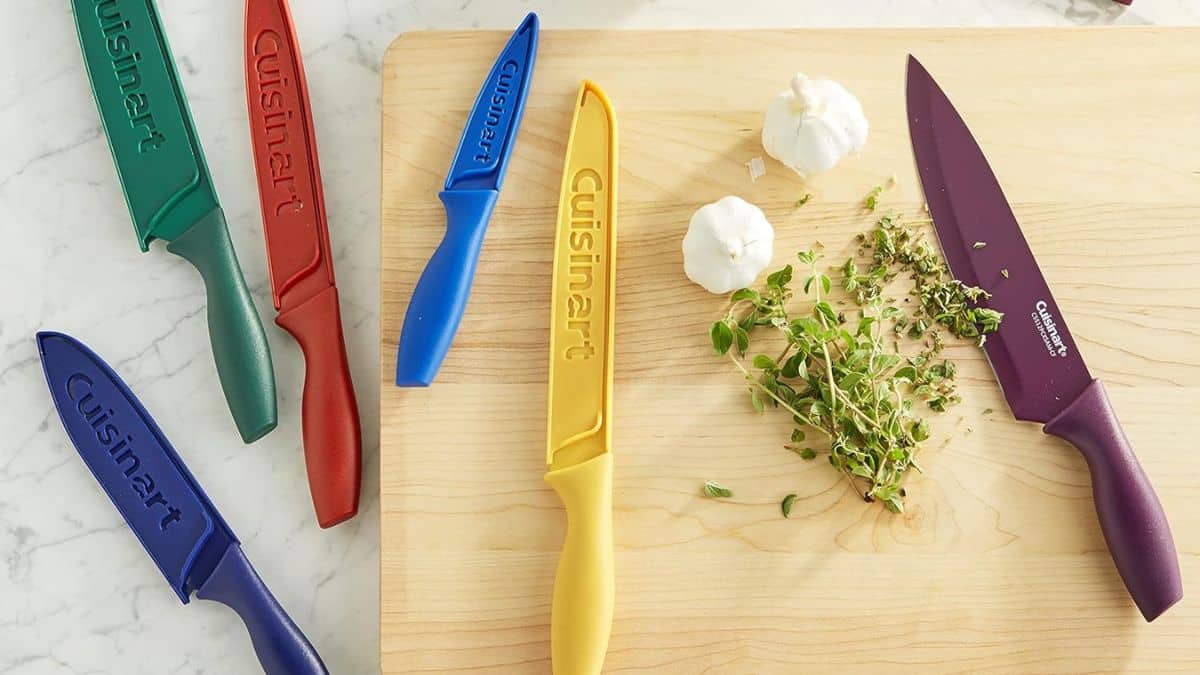
This 12-piece set of ceramic-coated stainless steel knives comes with the most common cutting knives that every kitchen needs, including chef, slicing, bread, santoku, utility, and paring knives. It also comes with matching blade guards to protect hands and fingers when not in use.
Each knife delivers precision cutting and ergonomic handles that make it comfortable and easy to grip. Well-liked for their maneuverability and versatility, these knives are perfectly sharp and very reliable, and because the blades are stainless steel with a ceramic coating, they’re more durable than standard ceramic knives. Plus, they’re available in a charming rainbow-colored set!
The Specs:
- Handle Material: Stainless steel
- Construction Type: Stamped
- Set Includes: Chef, slicing, bread, santoku, utility, and paring knives with matching blade guards
The Pros:
- Inexpensive
- Very sharp
- Non-stick coating
- Includes a variety of knife types
The Cons:
- Ceramic coated
- Not dishwasher safe
- Will get rusty over time if not hand-washed
- Paint may flake off the handles
What Others Are Saying
Named best budget by The Spruce Eats, the Cuisinart Advantage Color Collection 12-Piece Knife Set also has a 4.8-star rating from more than 25,625 reviews on Amazon.
Buy the Cuisinart Advantage Color Collection 12-Piece Knife Set with Blade Guards:
Other Ceramic Knives to Consider
KitchenAid Classic Serrated Bread Knife
This 8-inch serrated knife is ideal for soft-crusted breads and pastries, like the brioche I use in my Brioche French Toast Casserole, or my Easy Homemade Bread. This knife is designed to resist oxidation, rust, and staining, and is also top-rack dishwasher safe. However, $18 for just one knife is relatively expensive, especially considering you can find some quality knife sets for as low as $25. To boot, reviewers are split on the overall quality and sharpness, and some even report blade chipping. The KitchenAid Classic Serrated Bread Knife is available at Amazon for $17.99.
Wolf War Kitchen Ceramic Knife Set
This inexpensive set may not be the best quality out there, but for this price, the four knives and a peeler makes a decent starter set for anyone still learning their way around the kitchen. Reviews report that these knives are best for people with small hands, but there are some complaints of dull blades and chipping after months of use. The Wolf War Kitchen Ceramic Knife Set is available at Amazon for $24.99.
This is a good knife overall for miscellaneous cutting jobs, but it’s not very durably made so it likely won’t last long. For amateur cooks who are just getting started and may not be super comfortable with knives, this would be a safe, reliable option. The Farberware Ceramic Chef Knife is available at Amazon for $14.99.
Wacool Ceramic Knife Set with Sheaths
With a 4.4-star rating and more than 3,900 Amazon reviews, this three-piece knife set has lots of positive ratings for its sharpness, quality, value, ease of use, and more. It comes with a 6-inch chef’s knife, a 5-inch utility knife, and a 4-inch fruit paring knife, so it hits on the three most common cuts. However, if you need more variety in your knife set, you’ll want to opt for a set with a wider choice of sizes. The Wacool Ceramic Knife Set with Sheaths is available at Amazon for $21.99.
Why You Can Trust Us
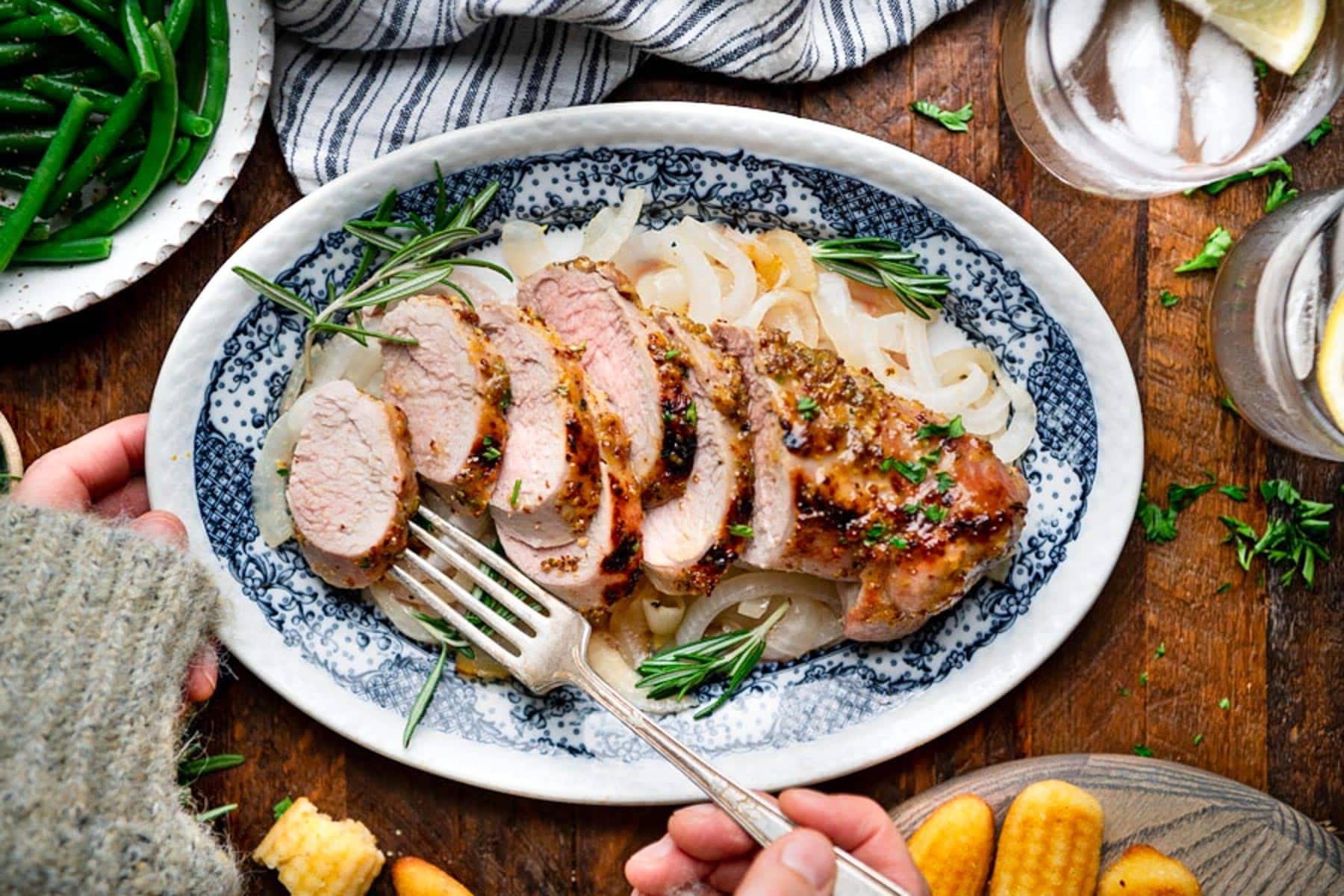
I’m Stephanie, a lifestyle writer and product reviewer, who is passionate about cooking. I paired up with Blair of The Seasoned Mom—a veteran cook who’s not afraid of chopping, slicing, or cutting—to work on this roundup of the best-rated ceramic knives for cooks of all knife skill levels.
We decided to come up with this list after seeing how popular ceramic knives have grown recently and thought readers may be interested in learning more about what makes ceramic knives special and so sought-after.
To start, we researched popular ceramic knives and knife sets and checked out buying guides from other culinary experts and trusted review sites. After comparing them all, we came up with our ultimate list of the best ceramic knives.
What to Know About Ceramic Knives
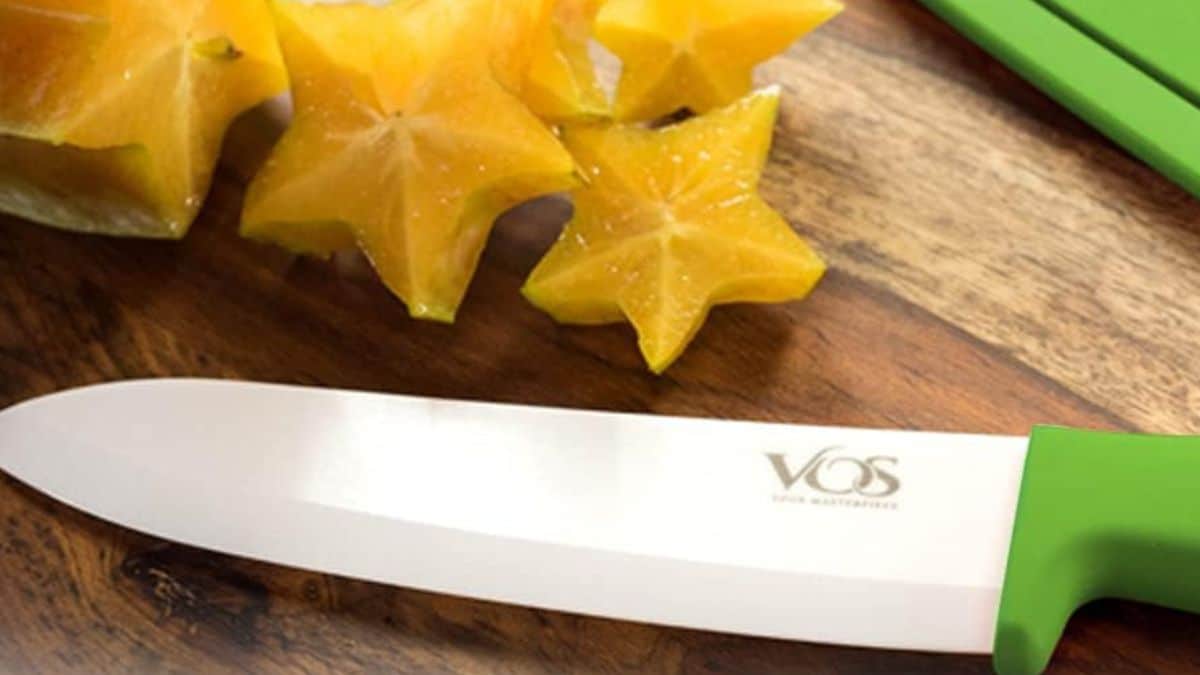
Things to Consider When Choosing Ceramic Knives
When considering the best ceramic knives, look into knife types, blade sharpness, comfort while using, and the size of the blade.
Knife Type: Different cutting jobs require different kinds of knives. Some of the more common ones you’ll find in the kitchen include a chef’s knife, a santoku knife, a paring knife, and a utility knife.
The chef’s knife is perhaps the most versatile, as it can slice, chop, and mince everything from vegetables, fruits, and herbs, to meat, thanks to its curved tip that slices smoothly.
Santoku knives have a unique precision edge that is ideal for dicing, mincing, and julienning very thin slices of either vegetables or meats.
Paring knives are most commonly used for peeling, mincing, and coring fruits, vegetables, and garnishes. The blades on paring knives are typically no bigger than 3.5 inches to allow for more precise detail while cutting.
Lastly, there’s the utility knife, which is also very versatile. You can use a utility knife’s straight, sharp edge and fine blade for cutting produce and slices of meat. Utility knives are usually also the go-to knife for other tasks, like quickly cutting open Amazon boxes or snipping off clothing tags.
Other types of knives to consider include bread knives and steak knives, which are both named after the food they’re intended for.
Blade: Ceramic knives are made from zirconium oxide, a specific type of ceramic. They are desirable because they are more likely to retain their sharpness over time, though they can be prone to chipping or breaking if dropped.
To test the efficacy of your ceramic knife’s blade, try the Basil Test. Stack a few basil leaves on top of each other, roll them up, then chop. A dull knife will result in bruised leaves that change color due to oxidation, and green marks on your cutting board. Wait about 15 minutes; if the basil leaves are still as vibrantly green as before, the knife is sharp; if the leaves have discolored, the knife is too dull.
Comfort: Most ceramic knives are designed to be pretty lightweight, but you should be comfortable holding and wielding the knife, and feel a sense of control and stabilization.
If it is ergonomically made and comfortable to hold, you shouldn’t have a problem time using it. If it feels too light or too heavy, you may want to try a different ceramic knife that fits your preference better. The knife handle material may also affect the comfort as handles can be made of plastic, wood, metal, or resin.
Size: A chef’s knife is typically 8 inches long, but can measure anywhere between 6 and 14 inches, so you will have to find the right length that is comfortable for you. Santoku knives are usually anywhere from 5 to 8 inches long, while a paring knife is typically 3.5 inches long, and utility knife blades range from 4 to 9 inches.
Are Ceramic Knives Good?
There are both pros and cons to owning and using ceramic knives. The best-rated ceramic knives last a very long time when cared for correctly, however, ceramic knives may break if they are dropped, thrown into the sink, or if you twist its blade.
It’s also not recommended to use ceramic knives on frozen foods as they are likely to chip or break, which is why some people think they’re more hassle than they are worth. By comparison, stainless steel knives will be more impervious to normal wear and tear, but will also need frequent sharpening. Ceramic knives stay sharper for longer periods of time, and may only need to be sharpened a few times throughout their life.
Are Ceramic Knives Better Than Steel Knives?
While there are pros and cons to both ceramic knives and steel knives, purists would probably say that ceramic knives are the better option. They can last longer, stay sharper for longer, and have a metal hardness of 8.2, compared to steel blades which have between a 4-6 hardness. The harder metal is why they stay sharper longer. However, since ceramic knives aren’t as durable as steel knives, they aren’t a good choice for cooks who are tough on their kitchen tools, as they may chip.
How to Sharpen Ceramic Knives
Diamonds are typically used to sharpen ceramic blades because diamonds are one of the materials even harder than ceramic. Kyocera offers professional blade resharpening for all of its products, but you can also buy the Kyocera Advanced Ceramics Diamond Wheel Knife Sharpener for $25 at Amazon.
Hold the knife sharpener on a level surface and put the knife blade vertically into the slot. Gently move it on the wheel backward a few times. Check for your desired sharpness, then rinse the knife after sharpening.
Note: Do not twist the blade while it’s on the sharpening wheel and do not use serrated blades on this sharpener.
Are Ceramic Coated Knives Safe?
There are ceramic blade knives, and then there are ceramic-coated blade knives. True ceramic blade knives are very sharp and do not rust, transfer a metallic taste to food, or oxidize fruits and vegetables, whereas ceramic-coated knives are made of high-carbon stainless steel blades that are treated with a ceramic non-stick coating.
Both types of knives will fare better if hand-washed, but if you clean your ceramic knife in the dishwasher, do so top-rack only. True ceramic knives can be ve, and a few dishwasher cycles can loosen them up and cause them to chip or break faster.
What’s the Best Cutting Board for Ceramic Knives?
Ceramic knives should only be used on either wood or plastic cutting boards in order to prevent the blade from chipping. Wood cutting boards are generally considered to be the best cutting board for ceramic knives—and most other knives, too—because of how durable and long-lasting they are. A wood cutting board also won’t dull a blade over time, which might be the case for some plastic cutting boards, and you should never use a ceramic knife on a glass cutting board.
Some of My Favorite Recipes
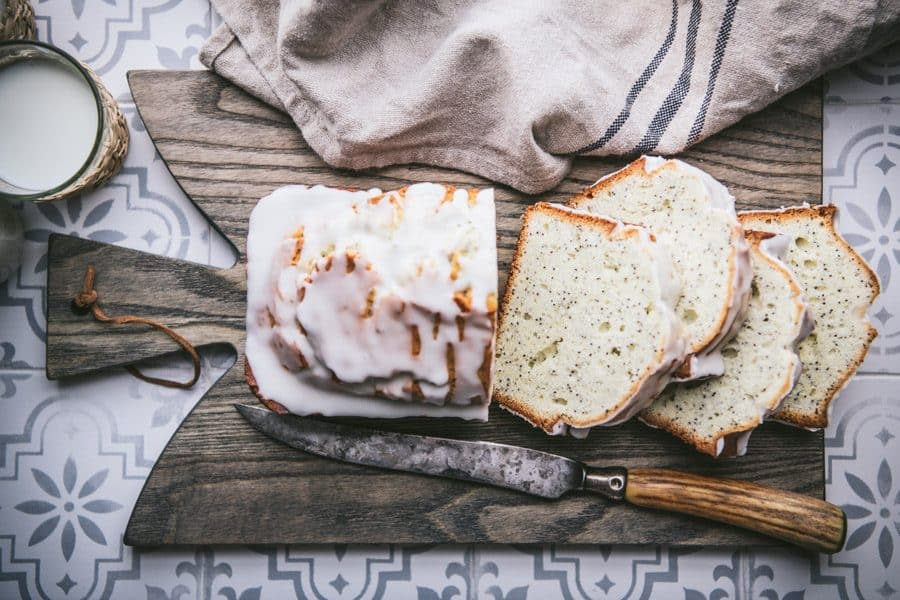
A good knife is a must-have for so many different kind of recipes, and now that you have the right ceramic knife for you, put it to the test with these reader-loved recipes:
- Smothered Round Steak
- Crock Pot Vegetable Soup
- Dutch Oven Beef Stew
- Green Salad with Red Wine Vinaigrette
- Poppy Seed Bread
Prices were accurate at the time of publication.

